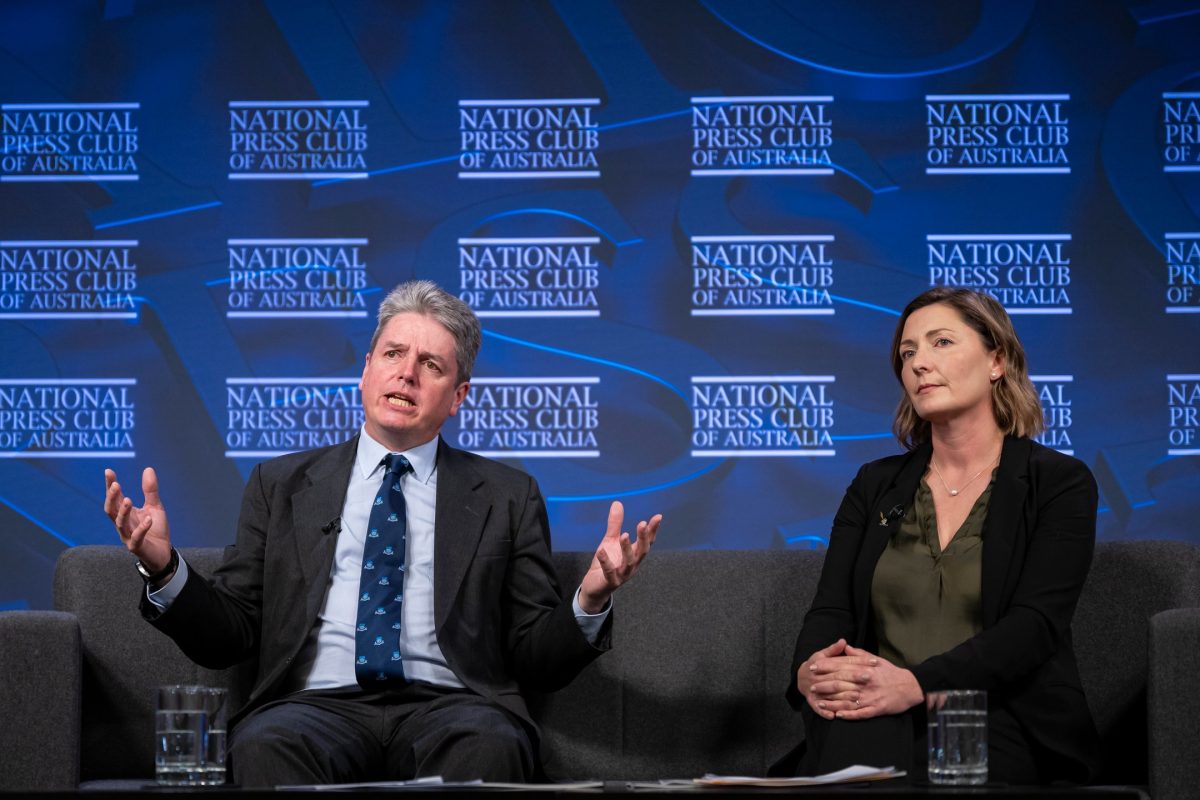
Professor Jamie Pittock and Professor Martine Maron launching ‘Blueprint to Repair Australia’s Landscapes’ at the National Press Club. Photo: Fernanda Pedroso.
Australia’s degraded natural environments could be repaired over three decades if the right action plan is implemented and if it starts now, says a group of highly regarded academics known as the Wentworth Group of Concerned Scientists.
Launching its Blueprint to Repair Australia’s Landscapes, the Wentworth Group used a National Press Club address to raise the alarm but also to offer the hope of a productive future if work is done as a matter of urgency.
The blueprint provides an evidence-based prospectus laying out a 30-year action plan and identifying public and private investment opportunities that would repair much of Australia’s damaged land.
It shows that repairing the natural environment is not only urgent and essential but also achievable and can be affordable if done properly.
Geography professor Jamie Pittock of Australian National University’s Fenner School of the Environment said the plan offered a nationwide strategy that should be instigated as a politically bipartisan effort.
“These interventions will help us to grow more food with our finite land and water resources in this, the driest continent on earth,” Professor Pittock said.
“We’re not trying to reinvent the wheel, but rather supercharge existing efforts and actions of so many Australians … This strategy needs oversight by a national council or similar body to coordinate implementation.
“Landscape repair must be driven bottom-up as well as top-down in a nation as culturally and environmentally diverse as Australia.”
The blueprint summarises the case for targeted investment, identifying objectives across soils, inland waters, native vegetation, threatened species and coastal environments – detailing the repair actions required, the estimated expenditure and the benefits of doing the work.
It identifies 24 actions worth $7.3 billion annually over 30 years, or 0.3 per cent of GDP, which could repair most of the past two centuries of degradation.
According to the report, the plan focuses on actions that would improve the condition of landscapes so they can provide a range of goods and services now and in a rapidly changing future, including nature-based solutions.
“Native vegetation actions identified could remove one billion tonnes of CO2, offsetting about 18 per cent of Australia’s net emissions over the next 30 years using high-integrity carbon methods, contributing to mitigation needed to meet obligations under the Paris Climate Agreement,” it states.
“At an average price of $35 to $75 per tonne of carbon dioxide equivalent, rising at 2 per cent per annum plus inflation from 2024, native vegetation actions on private land could generate $0.5 to $1.1 billion per annum in carbon market revenue within 30 years, reducing the annual investment needed to between $6.2 and $6.8 billion (2022$).”
Environmental management professor Martine Maron from the University of Queensland said some current million-dollar environmental initiatives were like “throwing little cups of water at a burning fire”.
“A task like this can feel overwhelming … I know I feel like that at times,” she said.
“That’s why this has to be broken down into achievable chunks.
“We need a costed step-by-step recipe and now we have one, which shows that it’s not an endless task and that Australia can afford to repair our landscapes … I think most people fully understand now the existential threat that climate change poses, and the urgency of addressing it, but we must also remember that nature loss is equally urgent and its impacts are intertwined with those in climate change.
“We absolutely must address both of those challenges together.”
Professor Maron said Australia was a world leader in extinction, habitat destruction and environmental degradation.
“But we don’t have to be,” she said.
“Our environment has been treated as an afterthought for too long and today we call the change. The evidence clearly shows that it is long overdue.”
The actions are detailed in the blueprint under these objectives:
- Improve physical and chemical condition and productivity of agricultural soils that need remediation due to long-term degradation and where that remediation is not likely to occur without direct investment
- Repair gully erosion hotspots across Australia to improve water quality in rivers and expand the availability of healthy land for agriculture and wildlife
- Connect agricultural land management practices with broader national ambitions for biodiversity, climate change and agricultural productivity
- Establish and restore riparian buffer zones on all of Australia’s rivers and streams to protect productive land from erosion, support biodiversity, improve water quality and enhance the productivity of fisheries and health of freshwater and marine ecosystems
- Restore overallocated river systems to sustainable levels of take
- Restore lateral and longitudinal connectivity of rivers, floodplains and their wetlands
- Improve the efficient use and sustainability of groundwater resources
- Restore native vegetation cover to at least 30 per cent of pre-1750 extent in a healthy ecological condition for each of Australia’s terrestrial ecosystems
- Reduce the frequency and intensity of fires impacting Australia’s tropical savannas
- Mitigate imminent extinction risk and ensure medium-term survival of Commonwealth-listed threatened species, and
- Support coastal biodiversity, and improve coastal fisheries productivity.













